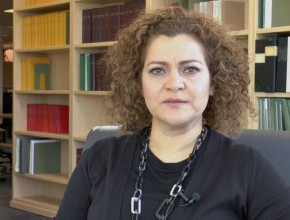Correction
The transcript was revised on March 6, 2017. Where it previously said "[inaudible]," it should have said "parenteral antihypertensives." A couple of minor edits were also introduced for clarity.
References
Qureshi AI, Palesch YY, Barsan WG, et al; ATACH-2 Trial Investigators and the Neurological Emergency Treatment Trials Network. Intensive Blood-Pressure Lowering in Patients with Acute Cerebral Hemorrhage. N Engl J Med. 2016 Sep 15;375(11):1033-43. doi: 10.1056/NEJMoa1603460. PubMed PMID: 27276234.Anderson CS, Heeley E, Huang Y, et al; INTERACT2 Investigators. Rapid blood-pressure lowering in patients with acute intracerebral hemorrhage. N Engl J Med. 2013 Jun 20;368(25):2355-65. doi: 10.1056/NEJMoa1214609. PubMed PMID: 23713578.
Roman Jaeschke: Good afternoon. Welcome to another edition of McMaster Perspective. I would like to introduce to you Doctor Jonathan Sherbino, with whom I usually meet in the emergency room. Today we meet in the library. Why don’t you tell us a few words of introduction?
Jonathan Sherbino: Thanks for the invitation. It is probably my first time here in the library. I did not know they still have books – I am in the digital age. I am an emergency physician, trauma team leader, and associate professor here at McMaster University. I think most helpful is that I am the chair of emergency medicine for the Royal College of Physicians and Surgeons of Canada. My academic background is in medical education, so I have a strong interest in knowledge translation, taking that bench-side research and making it implementable and translatable to our frontline clinicians.
RJ: It is very good. All this introduction will likely subject you to more requests from my side. We were thinking about talking about some recent or fairly recent papers that could be of practical application to our listeners. The first one deals with acute blood pressure management for intracranial hemorrhage. I wonder if you could tell us, succinctly, what the paper is about?
JS: The paper is one the emergency medicine community has been really looking to. It is called ATACH-2 and was published in 2016 in the New England Journal of Medicine. It is a follow-on to some recommendations in 2015 from the American Heart Association (AHA) as to how to best manage blood pressure in the symptomatic intracranial hemorrhage patient. A previous study, INTERACT2, had suggested – although the findings never met statistical significance – that blood pressure should be managed aggressively to reduce patients’ blood pressure as quickly as possible to a systolic blood pressure of less than 140 mm Hg. The actual fine wordings of the AHA guideline says that it is safe to do so, followed by some interesting grammar that says it may have some potential good patient outcomes, although the data in that study never reached the level of clarity that would necessarily affect my practice. Yet that consensus guidelines seem to adopt it.
ATACH-2 looked at 1,000 patients and was stopped early because of futility, so you know where my analysis of this paper is going to go. These were [patients with] small- to moderate-size supratentorial hemorrhage, typically in the basal ganglia, that presented within 4.5 hours and had their blood pressure reduced using intravenous nicardipine, a drug that is not available to us here in Canada but is probably the number one intravenous antihypertensive used in the United States, and I suspect around the world; at least in my experience in the US.
RJ: This is a calcium channel blocker?
JS: It is a calcium channel blocker that is very easy to titrate, very rapid in offset if you overstep your bounds, and does not have the same heart rate-parameter challenges as probably our number one agent here in Canada, which would be intravenous labetalol.
The study was stopped because with very rapid lowering of blood pressure to an aim of less than 140 mm Hg, although the median number was around 110 mm Hg, they found no benefit to the control arm where they aimed for a blood pressure control of 140 to 180 mm Hg. The challenge then, of course, was that they saw some negative outcomes, some side effects in this group. Effectively, if you look at your primary outcomes, even the secondary outcomes, there was no difference in terms of aggressive control of blood pressure versus standard control. I think what this means to me as an emergency physician – my concern, at least from a first-principles or a pathophysiologic point of view, is I want to reduce the size of hematoma formation. It makes sense from a first-principles point of view that if we can maintain blood pressure at a lower level, hematoma should not expand, and subsequently intracranial pressure (ICP) should not rise, and subsequently patient deterioration should not happen. Sounds great on paper, and yet when we look at this true, authentic prospective randomized but open nonblinded study, the patient-oriented outcome that we want most to see is, are you dead or are you disabled; there is no difference.
I guess my answer – moving forward from this study – I do want to control blood pressure in my patients but the range I am going to be looking for is between 140 and 180 mm Hg, not aggressively less than 140 mm Hg and probably closer to 110 mm Hg that we saw in these patients, because if you look into some of the subgroup analyses, there actually may be potential harm here.
RJ: Thank you for this. I guess it will change not only emergency physicians’ practice but also internists’ who get to this person, or neurologists’ or neurosurgeons’ or intensive care physicians’, so it really will apply – even though it was the first 24 hours of management – it will apply to a variety of specialties.
JS: I think that is an important point to pick up. If I put an arterial (A) line in, and put somebody on an IV labetalol infusion, it changes the course and pathway of their care; we are going to go to an intensive care environment. What we do know – and it is probably a whole package of care – is that stroke patients are best managed by stroke neurologists in stroke units. In a number of stroke units, or at least the ones I am familiar with, I would probably be less than comfortable dealing with an A line and ongoing parenteral antihypertensives...
RJ: “A line” meaning arterial line?
JS: Yes. So that would then take that patient out of the care of a stroke neurologist, with all of the other bundle of care that is going to provide good care for them, and put them into an intensive care setting where there may be an apples-to-oranges comparison about the other bundle of care that may not be standardized for them. There may be some hidden or unintended consequences downstream when we start being too aggressive, managing a number rather than looking at a patient-oriented outcome.
RJ: Related questions. In these patients, I think there was usually a [volume] limit of 60 mL of bleed and the mortality was 7% or so. They had mild to moderate severity of intracranial hemorrhage. How would we translate it to severe strokes with decreased level of consciousness, with signs of increasing intracranial [...] pressure? Can we somehow apply the results of this study to this slightly different population?
JS: I think what we are seeing in the ATTACH-2 patient population inclusion criteria, where you have the mild to moderately symptomatic patient, that is the patient that gives me the most angst because those are the people in whom I have the best ability to change or demarcate their progression of disease. In those catastrophic hemorrhagic strokes where you see significant evidence of hydrocephalus, raised intracranial pressure, definitive or restorative therapy is a rare finding. I am certain we want to mitigate further injury but I am afraid the cows are already out of the barn.
 English
English
 Español
Español
 українська
українська






